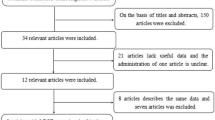Abstract
Purpose
Pharmacological therapy is typically the first-line treatment for patients with benign prostatic hyperplasia (BPH). We carried out a systematic review and meta-analysis to assess the efficacy and safety of silodosin for treating BPH.
Methods
A literature review was performed to identify all published randomized placebo-controlled trials (RCT) of silodosin for the treatment of BPH. The search included the following databases: PUBMED, EMBASE, and the Cochrane Controlled Trail Register of Controlled Trials. The reference lists of retrieved studies were also investigated. A systematic review and meta-analysis were conducted.
Results
Four publications involving a total of 2,543 patients were used in the analysis, including 3 RCTs that compared silodosin with placebo and 3 RCTs that compared silodosin with tamsulosin. We found that silodosin was effective in treating BPH in our meta-analysis. Total international prostate symptom score (IPSS) (P = 0.92 SWD = 2.92 95 % CI = 2.19–3.65 the mean decrease of total IPSS was from 6.4 to 10.6), voiding symptom score, storage symptom score, and quality-of-life score indicated that silodosin was more effective than the placebo. Silodosin’s efficacy is similar to that of tamsulosin (P = 0.37 SWD = 1.14 95 % CI = 0.18–2.11) in our meta-analysis. However, the incidence of abnormal ejaculation was higher in patients treated with tamsulosin therapy compared with the placebo (234/1128 = 20.74 % 12/680 = 1.76 % 6/736 = 0.82 %).
Conclusions
This meta-analysis proves silodosin to be an effective and safe treatment for the relief of lower urinary tract symptom associated with BPH. Silodosin and tamsulosin were similar in terms of efficacy. The major adverse event associated with silodosin treatment was abnormal ejaculation.






Similar content being viewed by others
References
Lepor H (2005) Pathophysiology of lower urinary tract symptoms in the aging male population. Rev Urol 7(suppl 7):S3–S11
Baazeem A, Elhilali MM (2008) Surgical management of benign prostatic hyperplasia: current evidence. Nat Clin pract Urol 5:540–549
Wu JP (2004) Wujieping urology. Shangdong Science and Technology Press, Jinan, pp 1143–1170
Roehrborn CG, Schwinn DA (2004) α1-Adrenergic receptors and their inhibitors in lower urinary tract symptoms and benign prostatic hyperplasia. J Urol 171:1029–1035
Kirby R, Andersson KE, Lepor H, Steers WD (2000) α1-adrenoceptor selectivity and the treatment of benign prostatic hyperplasia and lower urinary tract symptoms. Prostate Cancer Prostatic Dis 3:76–83
Tatemichi S, Kobayashi K, Maezawa A et al (2006) α1-Adenoceptor subtype selectivity and organ specificity of silodosin (KMD-3213). Yakugaku Zasshi 126:209–216
Akiyama K, Hora M, Tatemichi S et al (1999) KMD-3213, a uroselective and long-acting α1A-adenoceptor antagonist, tested in a novel rat model. J Pharmacol Exp Ther 291:81–91
Akiyama K, Noto H, Nishizawa O et al (2001) Effect of KMD-3213, an α1A-adenoceptor antagonist, on the prostatic urethral pressure and blood pressure in male decerebrate dogs. Int J Urol 8:177–183
Yu HJ, Lin ATL, Yang SSD et al (2011) Non-inferiority of silodosin to tamsulosin in treating patients with lower urinary tract symptom (LUTS) associated with benign prostatic hyperplasia (BPH). BJUI 11:1843–1848
Chapple CR, Montorsi F, Tammela TLJ et al (2011) Silodosin therapy for lower urinary tract symptoms in men with suspected benign prostatic hyperplasia : results of an international randomized, double-blind, placebo-and active-controlled clinical trial performed in Europe. Eur Uro 3:342–352
Marks LS, Gittelman MC, Hill LA et al (2009) Rapid efficacy of the highly selective α1A-adenoceptor antagonist silodosin in men with signs and symptoms of benign prostatic hyperplasia: pooled results of 2 phase 3 studies. J Urol 181:2634–2640
Kawabe K, Yoshida M, Homma Y et al (2006) Silodosin a new α1A-adenoceptor-selective antagonist for treating benign prostatic hyperplasia: results of a phase three randomized, placebo-controlled, double-blind study in Japanese men. Low Urin Tract BJUI 5:1019–1024
Marks LS, Gittelman MC, Hill LA et al (2009) Silodosin in the treatment of the signs and symptoms of benign prostatic hyperplasia: a 9-month, open-label extension study. Urology 74:1318–1322
Shibata K, Foglar R, Horie K et al (1995) KMD-3213, a novel, potent; α1A-adenoceptor-selective antagonist: characterization using recombinant human α1-adenoceptors and native tissues. Mol Pharmacol 48:250–258
Schwinn DA, Roehrborn CG (2008) α1-adrenoceptor subtypes and lower urinary tract symptoms. Int J Urol 15:193
Schou J, Holm NK, Meyhoff HH (1996) Sexual function in patients with symptomatic benign prostatic hyperplasia. Scand J Urol Nephrol Suppl 179:119–122
Emberton M, Neal DE, Black N et al (1996) The effect of prostatectomy on symptom severity and quality of life. Br J Urol 77:233–247
Scarpa RM (2001) Lower urinary tract symptoms: what are the implications for the patients? Eur Urol 40(Suppl. 4):12–20
Acknowledgments
We thank American Journal Experts for assisting in the preparation of this manuscript.
Conflict of interest
The authors had no conflicts of interest to declare in relation to this article.
Author information
Authors and Affiliations
Corresponding author
Additional information
Huantao Zong: Co-first author.
Rights and permissions
About this article
Cite this article
Cui, Y., Zong, H. & Zhang, Y. The efficacy and safety of silodosin in treating BPH: a systematic review and meta-analysis. Int Urol Nephrol 44, 1601–1609 (2012). https://doi.org/10.1007/s11255-012-0261-6
Received:
Accepted:
Published:
Issue Date:
DOI: https://doi.org/10.1007/s11255-012-0261-6




